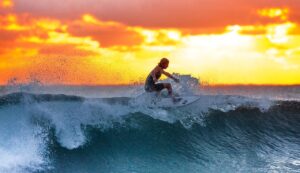Kneeboarding is a hybrid water sport that combines the excitement of wakeboarding and water skiing with the danger of surfing.
Kneeboard surfing, also known as kneeboard surfing or knee-riding, has long been a type of stand-up surfing alternative, but it has evolved into its own water sport over time.
Kneeboarders enjoy a feeling of speed closer to the water’s surface, so they frequently claim that the sensation of speed is greater in kneeboarding than surfing.
Kneeboards are extremely mobile, but you’ll need to learn how to balance the board, where and how to distribute your body weight, and how to adjust your upper body as the wave changes.
Kneeboarding is still a thing. Although it isn’t as popular as it was in the 1960s and early 1970s, it is still an exciting method to travel over big or little, mushy or hollow waves.
A kneeboard is a board with two fins, one being in the back and the other in the front. It’s typically between 5’6″ and 6’2,” depending on the conditions, the board, and the rider’s preference.
When learning how to stand up on a SUP, it’s critical to understand what you’re dealing with. A surfboard is perhaps longer and flatter than a SUP, with a fish or diamond tail and wide, circular nose.
Swimmers should use swimming fins to assist them enter the wave and steer the board faster in the key section of the journey.
Back and front-foot traction pads are popular kneeboarding accessories, but the traditional gripping method is always available: wax.
Kneeboard Surfing
Now, let’s get down to it and begin our prayer from a kneeling posture:
1. Its peak is visible in the distance, a four-foot wave.
2. Create a huge wave by paddling with your arms and kicking with your feet.
3. When you think you’re in the wave, push the board with your hands and raise up.
4. Look where you want to go as you slightly bend your legs.
5. To accelerate, use your hands if necessary.
6. Get out of the way.
7. With your hand, grab the outside rail.
8. Keep your inside hand near to water for balance.
9. If you’re paddling with both hands, push the board down the line with your legs or pump it up and down with your knees for more speed.
10. Make sure to lower your stance and use both hands to support turns, 360 spins, and off-the-lip tricks.

